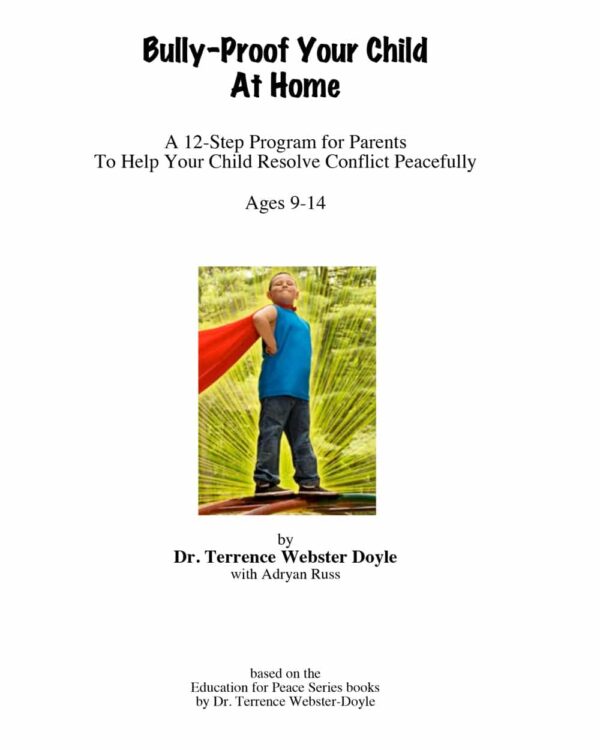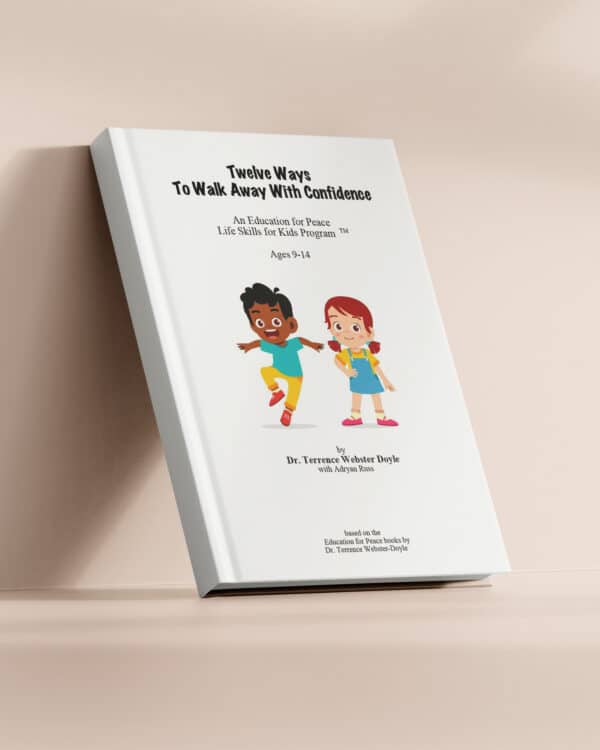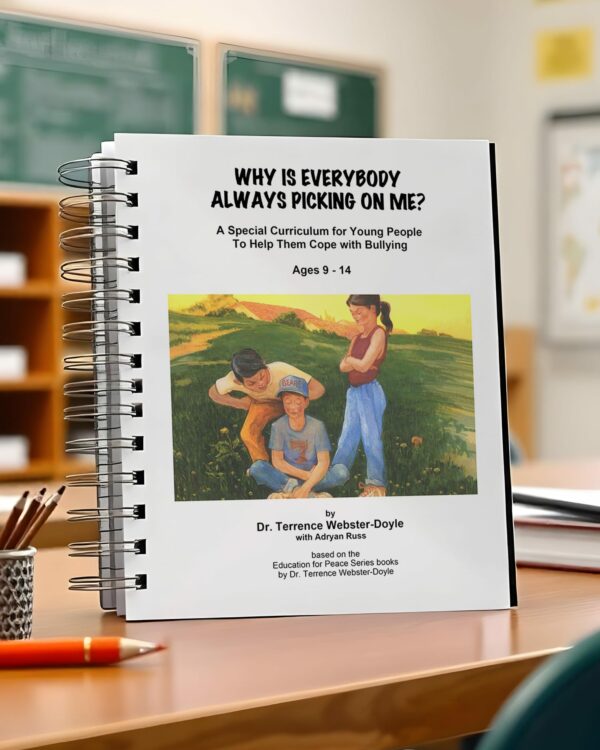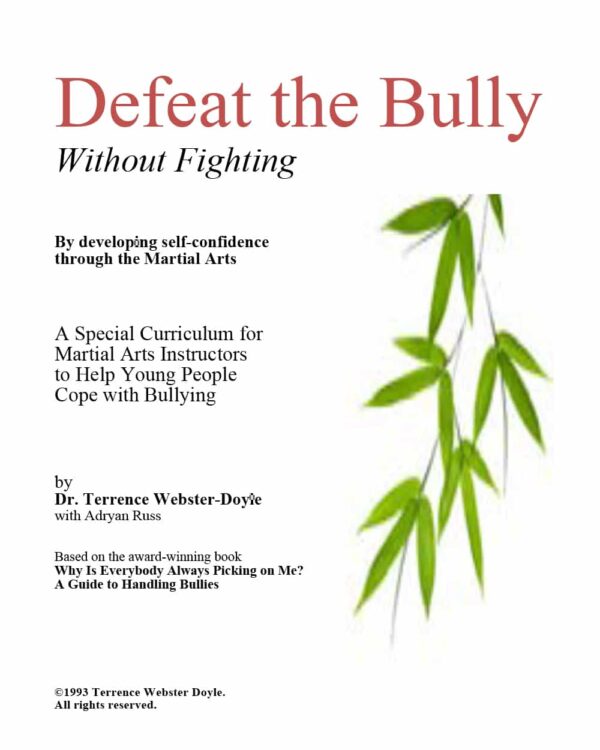Episode #7: How to Make Bullying Education Fun
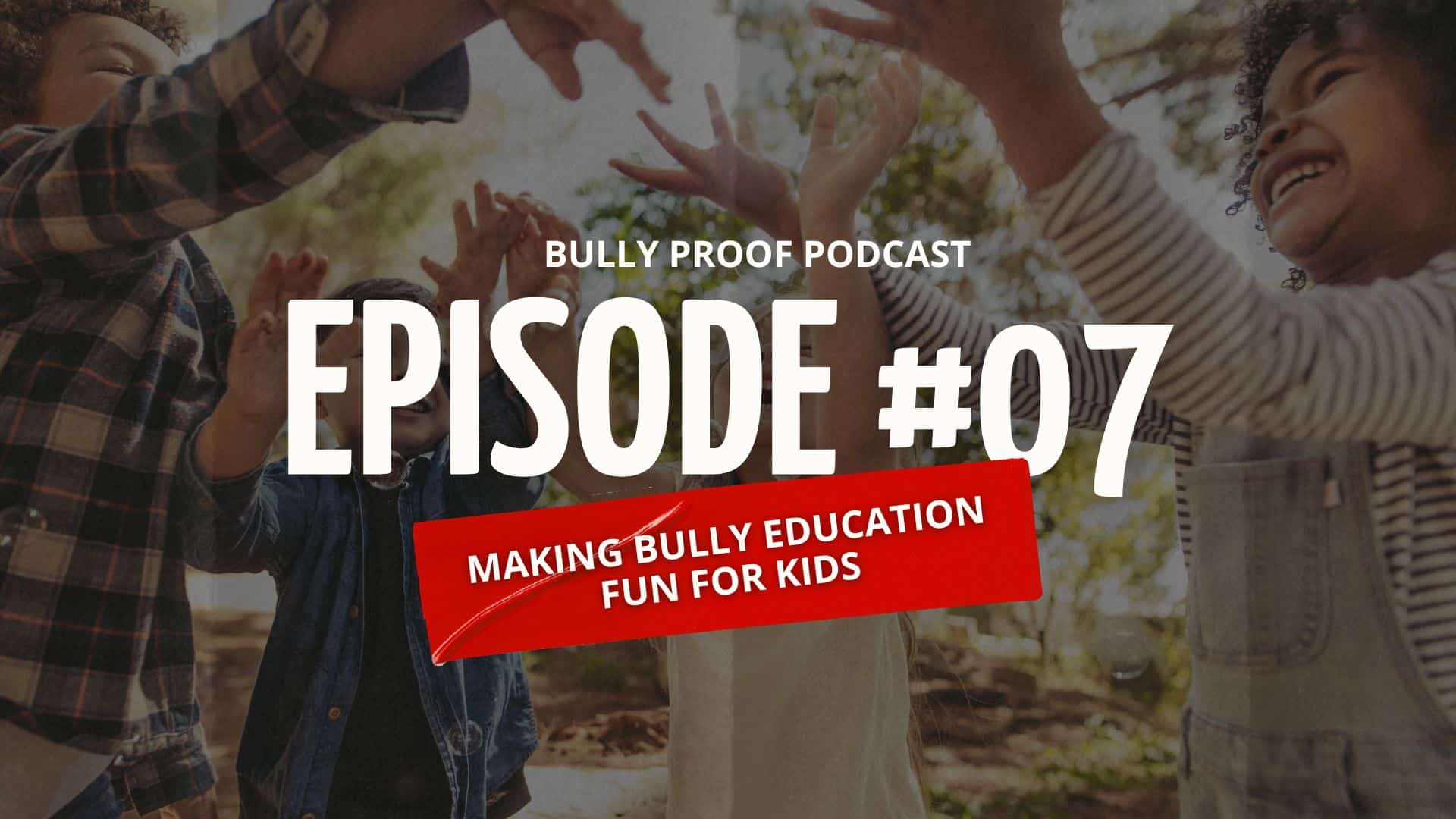
Teaching kids about bullying doesn’t have to feel heavy or overwhelming. In this episode of Bully Proof Your Child, we explore how bringing fun, playfulness, and creativity into bullying education can make lessons stick and help kids build confidence, empathy, and real-life skills they’ll carry for years to come.
Sam and Gary share practical ideas for parents, teachers, and caregivers, from role-playing and storytelling to movement-based activities and kindness challenges. You’ll hear how these simple, engaging strategies can break down walls, start meaningful conversations, and give kids the tools they need to handle difficult situations with confidence.
Whether you’re teaching at home, in the classroom, or at camp, this episode is packed with tips to make bullying prevention interactive and impactful.
Podcast Transcript
Welcome to Bully Proof Your Child, this is the podcast for parents, teachers and anyone who wants to help kids grow up kind, confident, and resilient. I’m Sam, a teacher trainer, and I’m here with Gary, who is martial arts teacher with a degree in psychology and a long time children’s learning center owner.
Together, we’ve been involved with the Atrium Society for over 30 years. In each episode, we share practical, proven tools from the Atrium Society’s 40+ years of peace education. It’s all based on the groundbreaking work of Dr. Terrence Webster-Doyle, who was a pioneer in bully prevention and emotional intelligence for kids.
You’ll hear lessons from MAP STARS, which is a signature program that helps kids build confidence, manage conflict peacefully, and grow into strong, compassionate leaders. These resources are simple, effective, and they’re made for everyone and we are so glad you’re here today.
So today we’re going to talk about something that’s little unexpected, which is how to make bullying education fun. I think, if we’re being honest, these conversations, because they can seem so difficult and the topic itself is super serious, sometimes can feel quite intimidating, but the way we teach, it really does not have to be. It can be a lot of fun. So if we are able to make it fun and interactive and playful, kids are much more likely to take that message and have it be very impactful.
So something we really need to remember is that kids learn better when they’re very engaged. Plus, it really lowers that pressure and creates a space where they’re able to feel safe and where they can be open and they actually want to participate in because that is what we need in bullying education, otherwise it can really just fall flat.
Today we’re going to talk about real ways that you can bring that fun energy into your classroom or your home or your camp group, whatever way you’re teaching. To start, let’s really dig into why it matters to be fun when we’re teaching kids about bullying.
The first thing I think is that it really builds engagement, which is what we want. When it’s fun, kids actually want to pay attention and they want to be involved. When the lesson feels like a chore, and I know I can attest to this, even as being an adult, you really check out and you don’t want to do it.
But if we’re able to make something feel like a game or a challenge, it’d be fun that they actually want to participating, they’re usually all in. Kids are pretty easy to get involved if it’s fun. They are way more likely to listen and way more likely to remember it too, because they’re actually engaged in what they’re learning.
Gary, I know you’ve worked a lot within your school. Have you seen some examples of this kind of play out?
Oh yeah, absolutely. When I first start working with kids on the subject of bullying, I’ll pull out a great big pad and list, you know, ask the kids to list, I’ll say, “what is a bully?” and I’ll get various answers, you know, and it’s always “Oh, they’re mean” and “they’re no no good“. And then we’ll go to the next phase. “Well, what does a bully look like?” And the kids in the class would get up and they’d make the face of a bully, and the other kids was would laugh and say, no, no, my experience is this, so he’d get up and show what a bully is. And so they started to engage with each other. They weren’t nervous talking about the subject, and they happily participated in that.
Yeah, that’s great. And they’re really learning from each other too. Because then, if one of the kids is showing like, what their bully looks like, but they maybe haven’t encountered the other one, they can see all those different examples of it.
Yeah, there are all kinds of different bullies.
Yeah, yeah, that’s awesome. It really shows that fun really does enforce that lesson. I mean, for example, say we are teaching about empathy. We could define it and talk about it all we want, which there’s definitely like a time and place to have those sit down lessons, or we could have a time when we’re actually engaging the kids in play. So we could ask them, or basically play a game, where we’re asking them to think how someone might feel in different situations and to really be put in that person’s shoes. So instead of just hearing the word empathy and kind of having a top level idea about it, they’re actually practicing what that looks like.
And the same really goes for things like assertiveness or teamwork. When kids get to actually be practicing those things in fun and playful and safe settings, they’re skills that they can actually be using again. It becomes not just a theory that they’re thinking about, it’s something they’re actually trying out.
A lot of times what I’ll do is, I’ll just describe kind of a sad story. You know, Sally went home and and she found out that her father got sick and had to be put in the hospital. How does that make you feel? And then we’d go around the room, and nobody liked that. They could all, and they’re all feeling sorry for Sally. And then we branch out into bully subjects. Well, what do you think, you know, this Jimmy on his bus route had a bully yelling at him and making fun at him the whole ride home to his house. How would that make you feel? And we would go around the room.
So we’re building empathy if you can identify with the victim, and ultimately, if you can identify with the bully, because we’d come around to that too. Well, what do you think is wrong with the bully? Why does the bully do this? And you know, it’s their knee jerk reaction would be, well, he’s mean. And I’d say, he’s mean. Why? And they’d say, “Well, maybe someone’s mean to him“. And I said, yeah.
It really makes me think of of what’s happening there.
There you go. And all the while they’re all happy to chime in. And, I mean, sometimes, we’ll even, you know, I had a couple of hats, and come out with a hat, and he was going to play the role of the bully. And, you know, and there was a little corner that was a timeout corner because the bully was in time out most of the day for doing these things.
So you get kids imaginations going, and they can grasp the whole idea of bullying and how people feel about it and why you should treat each other nicely.
Yeah, that’s great. I mean, it’s interesting too, doing it from having the kids practicing the bully and also the victim, because they’re really seeing both sides of that situation, then because if they’ve mostly only been a victim, then they are more empathetic to what’s going on with the bully and why they’re acting that way, or vice versa.
100%.
It really shows that fun makes it a lot easier to be talking about this, as well as the emotional side of it, because talking about bullying is not usually everyone’s cup of tea. Most of us, it’s not something we want, usually, to be talking about, but by making it fun, that conversation is a little easier.
Oftentimes, kids and adults too, when we’re having, or when we’re being on the receiving end of bullying, or if we happen to bully and we’ve been maybe made mistakes that we aren’t proud of, it just makes us maybe want to shut down if this conversation is brought up. So if we can make it fun and make it a little less serious, then those walls can come down as adults and as kids. I know it happens to me all the time. If a conversation gets a little too serious, those walls go up. So that’s why we want to make it fun.
Yeah.
When we can make that energy in your classroom or your, wherever you’re teaching this, make it light and fun and playful, kids feel safe in that and they are way more likely to open up and have these conversations and be receptive to what we’re trying to teach them. You’ve probably seen this?
Yeah, the fun becomes series. Okay, we started out by having fun, but we finish off by having a very serious conversation about how impactful bullying is and about what we can begin to do about it. But it’s a great warm up exercise to get them paying attention and participating.
It is. It makes it less scary. Instead of it suddenly being like, oh, we need to sit down and have this really serious conversation, you can make it actually feel playful and fun and inviting to start that conversation, at least
Right, right. And I think with with the MAP STARS program, it actually gives you some role play that you can use. And, you know, the 12 Ways to Walk Away, because what we do with some of the kids is we pick one of the twelve ways every week and and we’d do a skit on it. But would have kids tell stories about how they could use it.
Yeah, that’s such a great way to get their creativity going and practicing what they could be facing in real life.
Yes.
Anti-Bullying Resources
So, now that we know why it’s important to be bringing fun into this very serious conversation, I figured we could talk a little bit about what that looks like in actual practice, which, you actually just mentioned some of that, which is role playing is a great way to be doing that. It’s a great way for kids to be practicing those really tricky situations without it being real. They can be using simple scripts, which we have in MAP STARS and 12 Ways and all our other curriculum.
So we can be using those scripts and those scenarios to let them figure out what these situations look like together. It gives them a real chance to be thinking through those different situations and trying out different responses, seeing what feels comfortable for them to say, seeing what their friends are saying is a great way to get some more ideas of things to do, in a safe setting so they feel comfortable practicing this.
Gary, I know you were just saying that you’ve done a lot of role plays with your students. What has that really been looking like in the impact that it’s giving them?
Well, what it does is, we’ll start out with a simple role play that’s fantasy. Yeah, you know Billy at the school, school bus, yelling at someone, and then it becomes real, because then the children will modify it. “Well, you know what really happened?” And you’ll actually be able to dissect some of the stories and begin to solve some of the problems. So I think role play is great to get the ball rolling.
Absolutely.
We could do one script and that we could spend two weeks off of that script, you know, because every child has a different take on it. But what we’re doing is we’re deepening the learning of what causes bullying, and we’re beginning to teach them how to diffuse it.
Yeah, how to respond to it. And when you are able to finally bring in those situations that’s actually happening to those kids, you’re really helping them know how to respond to that when it happens again.
Yes, yes.
Which is so important. Another thing that we often like to use is storytelling. I know Dr. Terrence Webster-Doyle has written many, many books that are great to be using, and because stories, they just embody such a great way to learn. There’s such a different way to learn than just sitting down in a lesson, which can be a little boring for kids. But then also we can be using with those stories, is having kids pull out their own lessons from those stories.
So they can be writing their own story from it, from maybe what’s happening to them. They can be making a comic of it, something like that, so they can be telling their own story what’s happening and sharing kind of their own values and their choices and how they want to be treating others through that story. Yeah, and it gives us some ownership over their story too. It lets them name what’s happening and really reflect on it and really create something quite meaningful around it. Which is, which is really great.
Yeah, I know one of the, one of the favorite stories with the kids in my class was by Dr. Terrence Webster-Doyle’s book, Why is Everybody Picking On Me? and the story is called The Day of the Bee Sting. What had happened was Dr. Webster-Doyle, as a young boy, was terribly bullied, and one day in his backyard, the bully pushed Terrence down and got on top of him, and a bee stung Terrence. Now, Dr. Webster-Doyle was like six-foot-six. Big guy. So, and I assume he was big at a young age
I really think so.
Yeah. But anyway, the the effect of the bee sting and the pain made him jump and the bully that was on top of him landed about 10 feet away. So the moral of that story, and then we go around the room, what was the moral of the story? And of course, Terrence’s moral of the story was, there was truth right there. I was much more powerful physically than this bully. So there was a lesson there.
And when you get into the MAP STARS program, you’ll find that bullying is pretty superficial. And if you know, I can speak of males more than I can female. So if a male detects that the person he’s about to bully is physically superior to him, he isn’t going to bully him, and that’s, you know, that’s just one of the ways to get out. But the kids love that story. Yeah.
It was always a favorite.
Yes, that was a favorite. Oh, tell it again. Tell it again.
Did they ever have their own stories that were kind of similar to that?
Yes. Well, I know of one. And of course, he, this young man was pretty introverted, never liked to talk about himself, and he had martial arts training from me, and he was outside of his school waiting to be bused home, and some bullies started coming at him, and he was sidestepping him. He’d throw him down, side step, throwing the other one down, and then get onto his school bus to go home. And his mother told me this, that, you know, he knew how to take care of himself, but more than anything else, he understood what they were trying to do, and he wasn’t frightened.
Well, that’s that is so important, and that just goes into right, actually, our next point is how movement is so important in bully education. And that is a big part of lot of our lessons, but specifically MAP STARS, where we’re teaching things like physical activities, like learning body language, your personal space, and how to carry yourself, and even some of those, like base martial art moves, so that in a situation like that, you do feel confident in yourself, and that you know how to just be confident and take up your own personal space, really, and show that confidence to the world in but in a respectful way, and it just makes them feel so much more confident in themselves. It’s not just like up in their head, where they know they can feel great about themselves, but physically as well.
He actually did this from lessons that we used to do. We used to call it Matador. So you’d stand and someone would run at you, and then you just blade your body, step to the side, and if their head was down, gently push down on the back of their head, and that makes them fall because they’re off balance. Especially with children, their heads are disproportionately more weighty than the rest of their body. So that that’s what happened.
But he was actually just doing those lessons that we did in school, and you don’t have to be a very skilled martial artist to do that, but we used to practice that every week or so. You know.
That’s a very simple move.
Yeah.
Having these movements are great for kids that struggle to sit still too, because it makes it so much more engaging and fun for them.
Well, I would find that in my class, I think the younger ones might give you 10 minutes, you know, with it, looking in your eye and less if they were younger. So I used to blend exercise martial arts drills, and then when they were winded and tired, I’d sit them down and would talk through. So maybe twice in the period of, you know, 45 minutes that we’d get to sit and talk.
Well, but, they’re learning so much more too, like when they’re doing the martial art moves, they are learning that bullying education, just in a different way, and they’re having fun doing it.
You know, some of these moves are in the MAP STARS program.
They are, yeah, it’s great resource for that.
Finally, so another really great way to bring fun into your bullying education is through kindness challenges. And this is great for all ages and can, it, honestly, does not take a lot of time. It’s really easy to incorporate, and I feel like it works quite well in either school setting or a home setting. Gary, have you ever done this? Or have any kind of like go tos?
Yeah. We, yeah, we would do a couple of things. We would, parents complaints to me always, you know, he won’t clean his room, he won’t put his clothes, he won’t put his shoes back where they’re supposed to be. So we used to have an orderly exercise where, this week, I want you to go home, and I want you to do these things without being told by your mother to do them. I want you to just do them. Clean up, you know, clean up your bedroom, take your clothes, throw them in the hamper, and put your shoes where your shoes are supposed to be, and with varying success, but we would do that.
And then we go to the next, you know, look an adult in the eye, and say thank you when you get something, or if you’re asking for something, say please, you know. And I had one student that said to me, he said, when I say please, adults like me. Yes, I said, it works both ways. And yes, they do like you and you feel good about, you know, doing it, yeah.
That is great.
Yeah, and that kindness you have, you have to practice kindness. So we would go through a little drill. Say something nice about the person to your left, say something nice about the person to your right.
That’s a great way to do it. Did you notice that after doing that, that there was a change in the kids?
Well, they became closer as a group. They became closer as a group. And of course, some of the martial arts moves we were doing, they had to learn from others, because people that have been doing longer would know how to do it better. So I always told the upper belts in my class that to help the lower belts, you just have to, that’s, I’m helping you and I’m an upper belt helping you, you need to show that same courtesy.
And we always had each people bow to each other. And I know that’s an Asian tradition, but what it says is, I am humble and I respect you. So the what the black belt, the big black belt that comes in, who’s been at it 50 years, and the white belt that just started, you’re both equal. You both out of each other.
That’s wonderful, yeah, but that’s such an important lesson to be able to take into the rest of your life too.
Yes.
To be humble, treat everyone with kindness.
And we would follow that up with, well, how do you like to be treated? And, you know, so those are lessons parents tell their kids that all the time, how would you like it if it happened to you. And, I mean, but those are real life lessons. But, but in the MAP STARS, you make it an important one.
Yeah, it’s not just something that’s maybe said when a conflict arises, or something like that. It’s taught more all of the time, and it’s a consistent lesson.
So I think something also we need to remember while doing this is not to forget to celebrate successes, because we have been talking a lot about ways to be incorporating fun into bullying, but then we want to make sure that kids are seeing the results of that and the work they’re putting into it. Where we can recognize when they handled a tough situation well. Maybe they’ve gotten into an argument with someone or a conflict, or maybe they’re showing some kindness, even if it’s really difficult for them to do.
I think it’s really important that we kind of point that out and celebrate it with them, and acknowledge that we are seeing what they’re doing, and that really helps them realize that what they’re doing is important and that it’s being noticed and making an impact.
Absolutely. I mean, I go back to my father, the most important thing to me with my father, was for him to tell me, Gary, that was a good job. Good job.
It goes so far.
So whether it’s through any of these things we’ve been talking about, role plays, art, movement, small acts of kindness, any of these things, it’s important to remember that the goal of bullying education is to make it fun. It just makes it so much more fun for kids, they are more likely to remember it and use it. It gives them chances to have better ways of interacting when they do get in these situations.
These activities all help build empathy and confidence in ways that they’re going to remember because they’ve actually been experiencing it and practicing it rather than just listening to someone talking.
Yeah, no, it’s, you know, it’s not something that happens overnight. It’s an incremental increase in their ability. That’s why there’s so many modules that you go through. But once, once they learn how to deal with bullies, they’re always going to know this.
It’s going to help them their entire life.
So this week, I think we can just practice one thing, it’s to pick a scenario that affects your child and keep it something simple, but that is real to them, and act it out together. Just practice that. See how it goes. Make it fun. Don’t make it too serious. Don’t make it too dramatic, just nice and calm. It could be something like maybe a friend is teasing them, or someone’s touching their stuff and they’re not enjoying that. Just try out all your different responses and what that can look like, and work out that together.
I agree, perfect.
The goal really is not perfection, but rather just to practice and practice and keep going at it.
It’s a definite journey. It is.
Well, thanks for watching us on Bully Proof Your Child. We hope today’s episode gave you something valuable to take into your home, classroom or community. To explore our MAP STARS program and other helpful tools, visit atriumsoc.org, or check the show notes in the for the links mentioned. And don’t forget, when you join our newsletter, you’ll save 15%.
We want this podcast to be a true community resource, so please send us your thoughts, questions or stories to po*****@*******oc.org, we’d love to hear from you. If you found this episode helpful, please leave us a review. It helps more people find the support they need to raise a confident, kind, and bully proof child.
